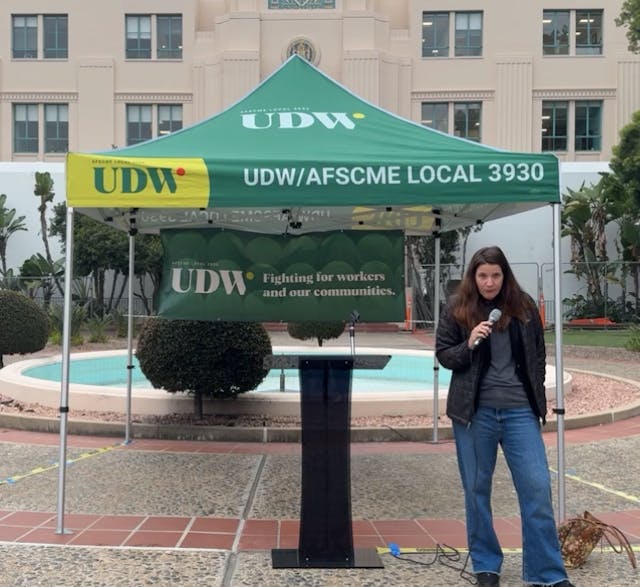Baja Bristles with Labor Protests
Frontera NorteSur
On the eve of May Day 2015, the Baja California Peninsula bristles with labor protests. Thousands of farmworkers and teachers have staged work stoppages, marches and occupations of government offices in recent days as they press demands for better wages and working conditions, back pay and dignified treatment.
Earlier declared extinguished by some observers, the farmworker uprising that shook the San Quintin Valley last month showed it was far from dead on Friday, April 24, when upwards of 10,000 workers staged a 15-mile protest march along the Trans-Peninsula Highway.
Many farmworkers hail from Triqui, Mixtec, Zapotec, Purepecha and other indigenous groups of southern and southwestern Mexico that have migrated to the fertile San Quintin Valley and now form the backbone of the labor force that produces strawberries, grapes and other products for the lucrative U.S. export market. Women workers were especially visible in the April 24 mobilization.
Farmworker leader Lucila Hernandez Garcia urged her co-workers to give the movement an extra “push” at a critical juncture. Placards carried by the workers demanded better treatment, benefits and the ouster of Baja California Governor Fransisco “Kiki” Vega de Lamadrid.
At one point during the hours-long march, workers waved Mexican flags as they passed by a property of Driscoll’s, the U.S.-based transnational that contracts many of the berries produced in the San Quintin Valley. Shouted the workers, “Our country, our countryside, the land belongs to those who work it!”
The San Quintin movement has crossed borders, inspiring the largest Mexico-U.S. labor solidarity campaign of recent years.
U.S. supporters, including farmworkers in Washington state who are immersed in a lengthy dispute involving Driscoll’s, have been picketing company sites and urging boycotts during the past few weeks. The movement is especially active in California, where the Binational Front of Indigenous Organizations (FIOB) connects Mexican communities that serve as a labor sources for both Baja California and California.
Among upcoming solidarity actions, the FIOB plans a demonstration at the large strawberry festival scheduled May 15 and 16 in Oxnard, California.
“The indigenous peoples’ social values of solidarity and community sense run into a system that treats them more as units of production than as human beings,” wrote Bertha Rodriguez-Santos, media coordinator for the FIOB. “And, in the words of Mixtec Francisco Lozano, who has worked in San Quintin as well as California, ‘it treats us like animals.’”
At the conclusion of their April 24 march the workers sat down in the town of San Quintin for negotiations with Mexico’s Interior Ministry and Governor Vega. The session was observed by officials from various government agencies, delegations from both chambers of the Mexican Congress, the National Human Rights Commission, the state human rights commission, and several unions.
Represented by the Alliance of National, State and Municipal Social Justice Organizations, the farmworkers seek a minimum daily pay rate of $15, access to social security and other benefits, and an end to sexual harassment of female workers. They also demand the revocation of sweetheart contracts between growers and unions affiliated with President Enrique Pena Nieto’s Institutional Revolutionary Party, and respect for an independent union.
Luis Enrique Miranda Nava, Interior Ministry undersecretary, pledged the federal government will intensify field inspections to ensure compliance with labor law and health standards; promote legal action against sexual harassment; enroll workers in social security and education programs; construct a daycare center and a hospital; and work for the creation of a new fund to help cover workers’ necessities.
But the key worker demand of an effective doubling of the daily wage was rejected by Alfredo Munoz, representative of the Baja California Agricultural Council, who repeated earlier employer offers of a 15 percent wage increase.
Leaders of the San Quintin workers vowed not only to maintain their demands in Baja California but to take their message and movement to the other states of the Mexican Republic in the coming days as well. More than two million farm laborers, with about 60 percent of them indigenous migrants from southern Mexico, are currently estimated as working in the country.
“The same situation of the violation of workers’ rights prevails in many places,” said Alliance leader Fidel Sanchez Gabriel.
Talks among the different actors involved in the San Quintin conflict are expected to resume on May 8.
In April, Governor Vega found labor-related matters filling his agenda. On April 24, before he returned home for the San Quintin negotiations, Vega met in Mexico City with Education Secretary Emilio Chuayfett over the controversy of back pay owed to Baja California’s public school teachers. For the last two weeks, the border state’s teachers have conducted rolling and indefinite strikes, camp-outs and other protest actions to further their demands.
On April 24, while farm-workers marched on San Quintin, more than 8,000 teachers rallied in the state capital of Mexicali.
Thousands of current and retired educators also protested in Tijuana and Ensenada. Sections of the institutional National Union of Education Workers (SNTE) and the Baja California State Resistance Movement, a left-leaning teacher grouping opposed to the 2013 education reform, both support the movement.
Part of the conflict is blamed on the education reform law that re-centralized payrolls in Mexico City and apparently caused confusion over who should get paid and for how much money. A similar problem of missing paychecks set off teachers’ strikes and protests in the southern state of Guerrero two months ago.
Juan Jose Ortega Madrigal, leader of the National Coordinator of Education Workers in the state of Michoacan, said teacher pay problems are also reported in Sinaloa, Jalisco, Zacatecas and Chiapas. “We think there will be many more,” Ortega added.
In Baja California, an estimated $60 million is owed to just the teachers belonging to the SNTE’s Section 2. Retired teachers are also owed back payments, according to Juan Vidauri Padilla, Mexicali coordinator of the retirees. Vidauri said 30 of his colleagues who were waiting for back pay have passed away during the first four months of 2015 alone.
The teacher protest movement has expanded to the state of Baja California Sur, in the southern half of the Baja Peninsula, where back pay owed to educators, overdue payments to the retirement system and the regularization of job assignments are boiling as hot issues. As last week drew to a close, members of the SNTE called for a general strike in Baja California Sur on Monday, April 27.
Frontera NorteSur: on-line, U.S.-Mexico border news Center for Latin American and Border Studies New Mexico State University Las Cruces, New Mexico



 Arturo Castañares
Arturo Castañares


